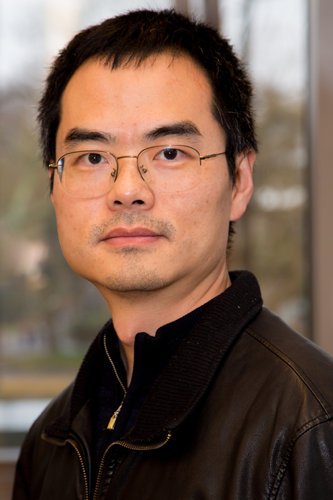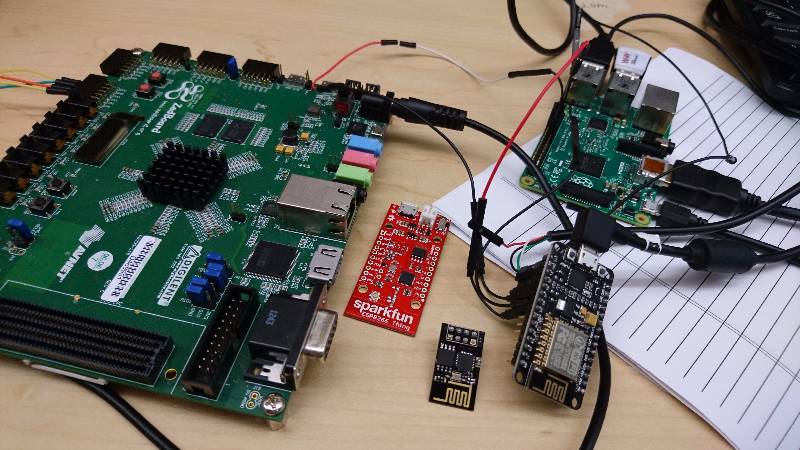Transforming Smart Technologies
NSF funding helps push the limits of today’s smart devices
 Today’s smartphone is often referred to as the “swiss army knife” of modern life.
For any purpose, there is an application, or “app” as they are universally known.
More often than not, there is not just one, but multiple apps at our fingertips to
meet our daily needs, from social, entertainment, and environmental to health and
transportation. However, there are boundaries to this immense convenience and flexibility
– it is limited to software only. For example, there is no app to measure the air
pollutant levels in the home. The reason is simple: as “smart” as today’s commodity
phones are, they are not equipped with special sensors that can measure these pollutants.
Such limitations in hardware - both sensors and radios - have been a major roadblock
to a true “swiss army knife” device whose hardware can be reconfigured to suit purposes
beyond commodity smartphones.
Today’s smartphone is often referred to as the “swiss army knife” of modern life.
For any purpose, there is an application, or “app” as they are universally known.
More often than not, there is not just one, but multiple apps at our fingertips to
meet our daily needs, from social, entertainment, and environmental to health and
transportation. However, there are boundaries to this immense convenience and flexibility
– it is limited to software only. For example, there is no app to measure the air
pollutant levels in the home. The reason is simple: as “smart” as today’s commodity
phones are, they are not equipped with special sensors that can measure these pollutants.
Such limitations in hardware - both sensors and radios - have been a major roadblock
to a true “swiss army knife” device whose hardware can be reconfigured to suit purposes
beyond commodity smartphones.
 |
 |
 |
| Fan Ye | Peter Milder | Yuanyuan Yang |
A team of faculty researchers in theCollege of Engineering and Applied Sciences at Stony Brook University received a $822,419 NSF award to help address this gap in smart technologies. Professors Fan Ye, Peter Milder and Yuanyuan Yangwill design, create and evaluate a novel hardware and software platform where modularized FPGA/software computation components can be easily composed like interlocking Lego pieces, to create customized edge sensing and computing devices for "smart" applications.
“At Stony Brook University, our researchers are passionately engaged in the most relevant issues of our time, pursuing ideas that lead to viable solutions,” said Stony Brook University President Samuel L. Stanley. “I look forward to tracking the progress of Professor Ye’s NSF-funded work. I am confident that it will greatly impact current smart application technology, and will very likely change how we are doing things today.”
In mobile computing, vehicular systems and the Internet-of-Things (IoT) scenarios, sensors or radios in varying types and quantities are necessary, such as a vehicle fitted with multiple cameras shooting at different directions and distances. This platform would create prototypes of different sizes and capabilities. The most powerful ones, at tablet grade, would have high peripheral capacity and computing power while smaller ones, at power-socket grade, would have less resources.

 Fan Ye, assistant professor in the Department of Electrical and Computer Engineering,
and the principal investigator on the NSF-funded project. “If successful, this would provide the ideal ‘swiss army knife’ device, far beyond what
current smartphones can offer, and a vibrant source for a myriad of future innovations.”
Fan Ye, assistant professor in the Department of Electrical and Computer Engineering,
and the principal investigator on the NSF-funded project. “If successful, this would provide the ideal ‘swiss army knife’ device, far beyond what
current smartphones can offer, and a vibrant source for a myriad of future innovations.”
By developing libraries that support different hardware and software functionality, users can pick and choose suitable modules and compose the hardware/software, connect sensors and radios, and conduct processing tasks, many of which could be compute-intensive (e.g., image processing, cryptography).
“Our faculty are truly inventing the future - pushing the boundaries of innovation and advancing research in the most important technologies in pursuit of a better tomorrow,” said Fotis Sotiropoulos, Dean of the College of Engineering and Applied Sciences at Stony Brook University. “Transforming smart technologies is one way we are making science fiction come to life every day.”
